“You won’t ever need another salad dressing recipe after you master one ratio.” That really turned a switch for me when I heard it in a small cooking class years ago. Every homemade salad dressing became simple, versatile, and, to be honest, kind of enjoyable once I perfected the basic recipe!
Despite its straightforward appearance, salad dressing is the secret to its flavour, texture, and nutritional value. While a creamy salad dressing can transform a simple bowl into dinner, a well-balanced vinaigrette makes greens taste like a restaurant plate. This guide is your shortcut to better, faster, and more dependable results if you’ve ever shaken a jar, tasted it, and thought, “Meh.”
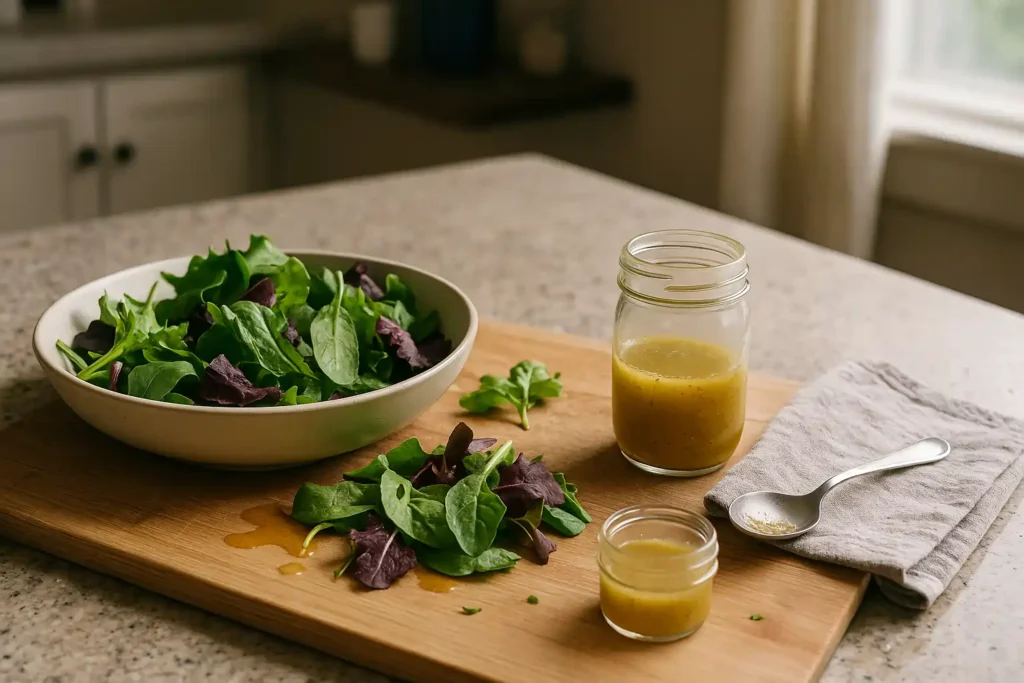
Table of Contents
Table of Contents
Why Dressings Matter (flavor, texture, nutrition)
A great salad dressing accomplishes three major tasks simultaneously. You’re not just chewing raw plants because it coats, seasons, and imparts flavour to every leaf. When the right balance is achieved, a handful of lettuce feels like a meal because of the bright acidity, rounded richness, and tiny pinch of salt.
After many ho-hum bowls, I discovered this. Salt is necessary to make everything pop, and fat and acid are necessary to wake up raw vegetables, which are primarily water. Even the most beautiful salad will taste bland or watery without those three, and the dressing is solely to blame.
Texture is more important than most people realise. Every bite feels the same thanks to proper emulsification, which allows the dressing to stick to the greens rather than settling at the bottom. I prefer lighter and silkier ingredients when tossing tender spring mix, but I want something with a little weight so it sticks if I’m tossing kale or cabbage.
A nutritious salad dressing is more than just “lower calorie.” It involves using smart emulsifiers to reduce the amount of oil you need overall, adding acids that add brightness without being sugar bombs, and selecting oils with good flavour and decent fats. For everyday use, I prefer extra-virgin olive oil because it tastes good, but for neutral or bold, I’ll use avocado or toasted sesame oil instead. The entire mood is altered by those decisions, and you can see this in my full guide to oil and vinegar dressing.
The realisation that I didn’t always need a new recipe was a turning point in my life. I needed a solid base and some adjusting tips. I add a dab of honey or even a splash of water if it’s too sharp. If it’s flat, I add a squeeze of lemon or a pinch more salt, and the bowl comes alive again.
The Master Ratio (oil:acid 3:1 vs. 2:1; when to bend the rules)
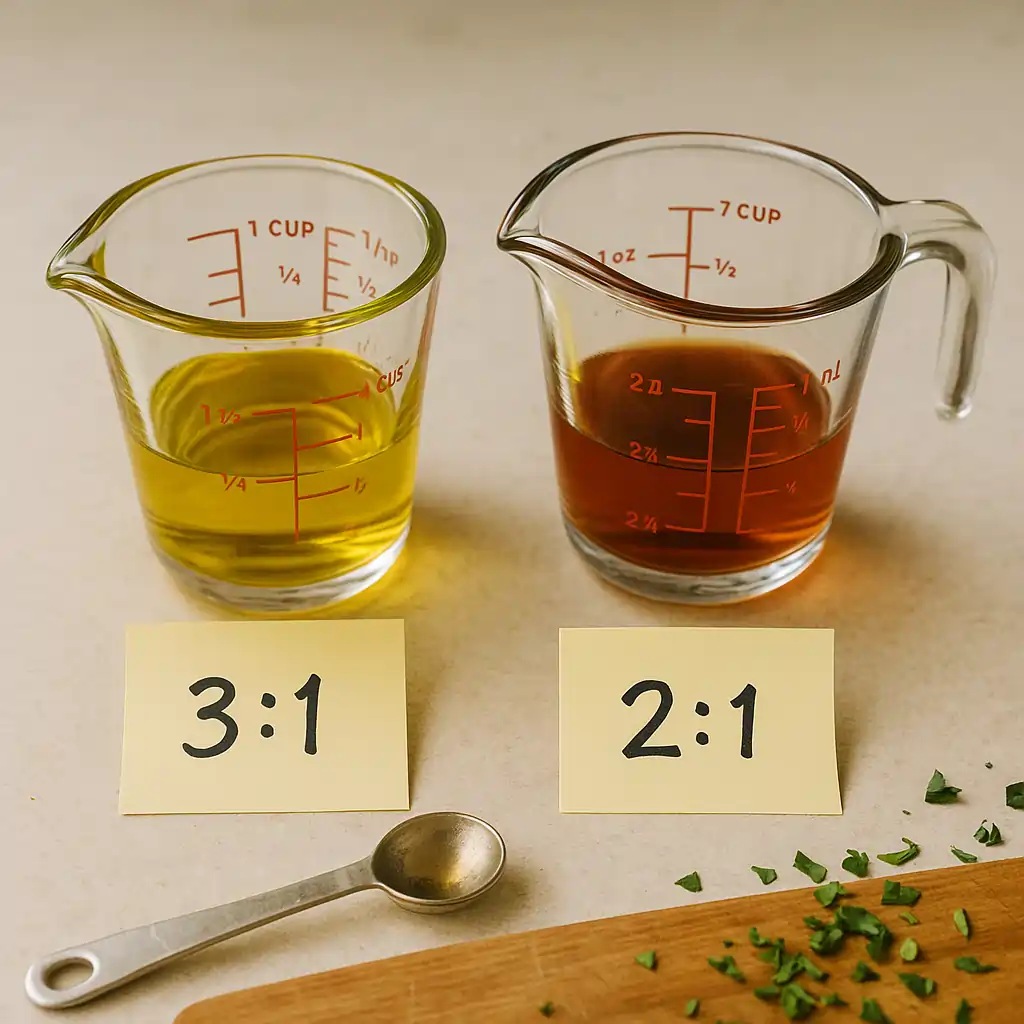
Since the vinaigrette ratio is the foundation of making salad dressing at home, let’s talk about it. Three parts oil to one part acid is the traditional ratio. The rounded, restaurant-style finish that most people associate with the 3:1 vinaigrette ratio is “yep, that’s right.”
Here’s the twist I always use, though. When I want a vibrant, healthful salad dressing or for juicy salads, I switch to a 2:1 oil to acid ratio and let the greens do the heavy lifting. After everything combines, the leaner ratio truly tastes balanced because tomatoes, cucumbers, and citrous segments add water and sweetness.
When can I break the rules even more? I can maintain a 3:1 ratio without getting greasy if my acid is mild, like rice vinegar. 2.5:1 or 2:1 can work well if my acid is sharp (such as lemon or apple cider vinegar), especially if I add a little Dijon to smooth the edges. While raw garlic or shallot can intensify acidity, soft herbs also reduce it.
The concept is the same for creamy salad dressing, but the “fat” is different. I’ll still think in portions and balance with water and acid if I’m using Greek yoghurt, avocado, tahini, or mayo. Since yoghurt and lemon have a strong flavour, I dilute it with water to reduce the calorie content and make it spoonable. Finally, I add salt to prevent it from becoming bland.
My “I made a mistake” tale. I once made a 3:1 mixture with pure lemon juice and extremely peppery olive oil, and it was delicious. The whole thing relaxed after I fixed it by whisking in a tablespoon of water and a teaspoon of honey. In other words, ratios are a map rather than a law.
Building Blocks (oils, acids, sweeteners, emulsifiers, aromatics, heat)
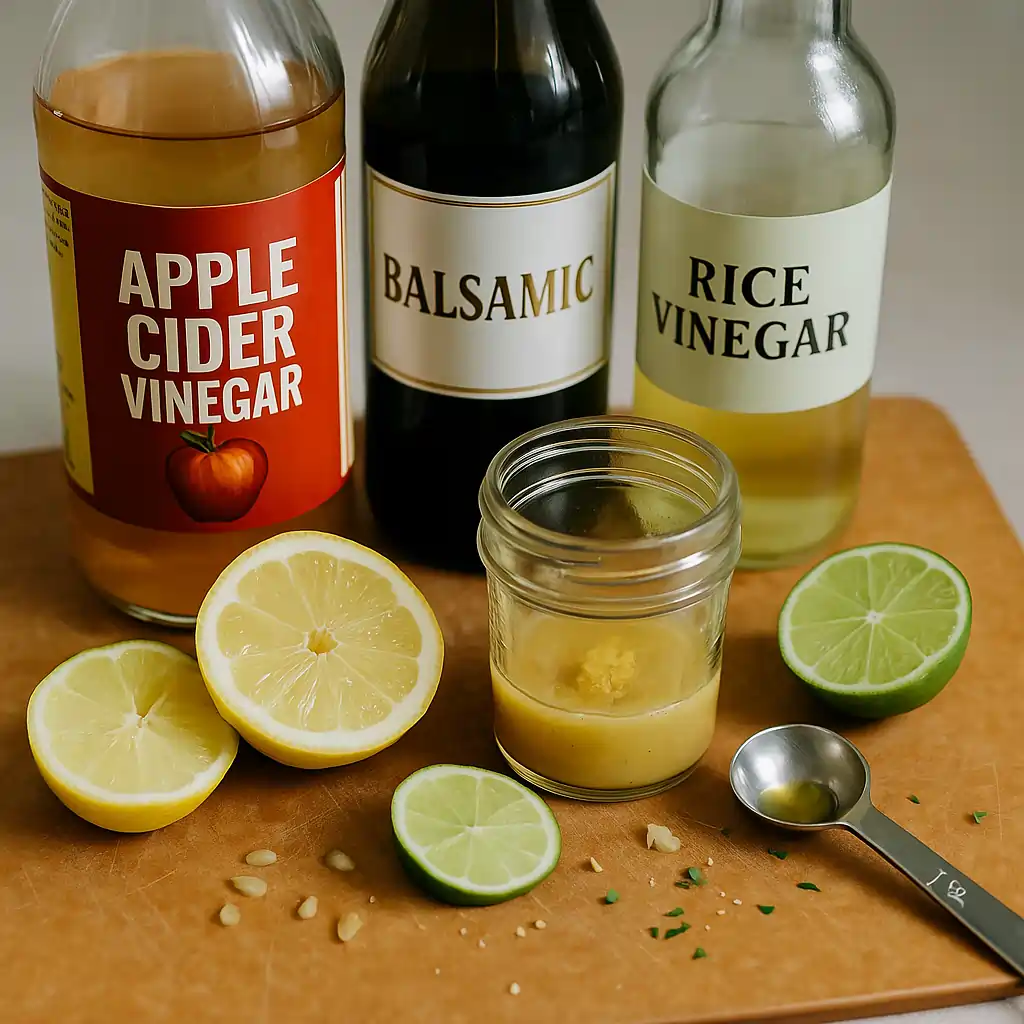
First, oils, as they create the mood. Avocado oil is clean and allows other flavours to shine, whereas extra-virgin olive oil is grassy and strong, making a simple salad dressing taste fancy. For delicate herbs or fruit-forward dressings, neutral oils like grapeseed or canola blend in with the background.
Your steering wheel is acid. Sherry vinegar is elegant without being fussy, apple cider vinegar is approachable and slightly fruity, and red wine vinegar feels traditional. Balsamic becomes rich and subtly sweet when it hits greens, lemon juice makes everything brighter, and lime adds a snap that goes well with cilantro.
Desserts are not made with sweeteners. To prevent acidity from penetrating, they simply round off the corners. When I want thickness, I use honey; when I want cosy depth, I use maple syrup; and when I don’t want the taste of the sweetener to be noticeable at all, I use a pinch of sugar. You most likely added too much if it tastes sweet.
Emulsifiers maintain the bond between acid and oil. Tahini acts as a natural glue, mayo adds a hint of creaminess, and dijon mustard is the mainstay. If you want that lux Caesar look, an egg yolk is a classic addition, and even a spoonful of Greek yoghurt will stabilise a vinaigrette.
Your personality is layered by your scents. Garlic becomes savoury after five minutes, finely chopped shallot becomes soft and sweet in acid, and fresh herbs like basil or dill create a basic flavour. When I want “whoa, interesting,” I also add spices like cumin, coriander, or smoked paprika.
Heat is fantastic but optional. Chipotle gives everything a smoky, bold flavour, a pinch of red pepper flakes enlivens a vinaigrette, and a little fresh jalapeño in lime dressing is the epitome of summer. Ask me how I know, but I’ve learned to start small because you can always add more heat, but you can’t take it back.
Methods (shake-jar, whisk, blender; when to add water, yogurt, avocado)
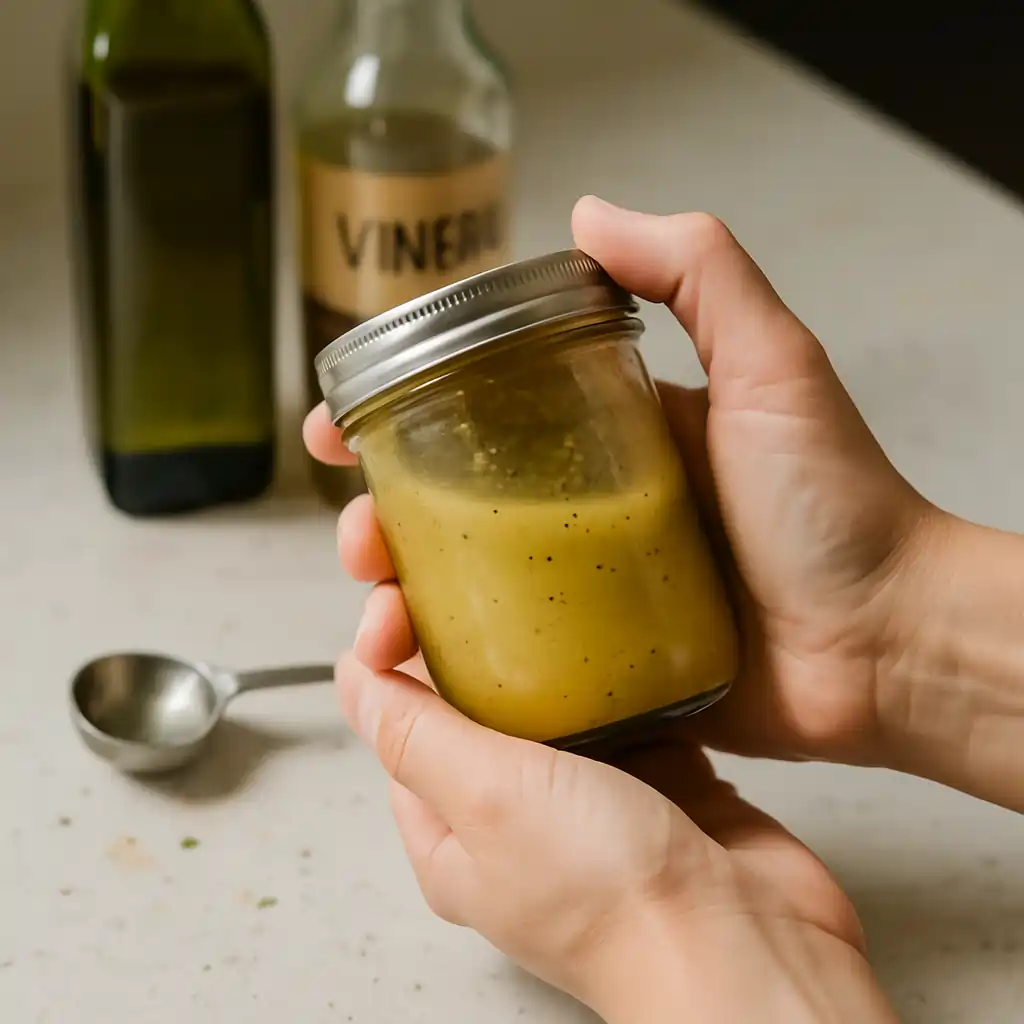
My weeknight hero is the shake-jar method. I start by adding the acid, salt, and any minced aromatics, then I wait a few minutes before adding the oil and shaking as if I’m serious. The vinaigrette isn’t pretty in the kitchen if I forget to tighten the lid, which has happened.
Whisking provides control but has an antiquated feel. I put the acid, salt, and any sweetener in a bowl, whisk in a tiny bit of Dijon, and then slowly pour in the oil. I pause and taste the ribbons when they appear thick and glossy because it becomes difficult to remove without significant adjusting once they get too greasy.
For smooth dressings or when I’m working with solids, I use blenders and immersion blenders. Sun-dried tomatoes, avocado, soaked cashews, or roasted red peppers all blend seamlessly with creamy salad dressing. To control thickness without adding too much fat, simply blend the acid and flavourings first, then pour in the oil and water by the tablespoon.
Water is not dishonest; it is a legitimate tool. A tablespoon or two helps a vinaigrette stick better to watery vegetables, cut calories, and thin out an overly rich vinaigrette. Additionally, because plain yoghurt can coat too thickly and feel chalky, I dilute yogurt-based dressings with water.
Avocado and yoghurt somewhat alter the rules. Since the tang in yoghurt can lead me to over-salt it at first and then intensify as it rests, I salt it last. Since avocado loves salt and lime and will appear bland until it comes into contact with greens, I blend it first, then taste it on a leaf.
My little piece of advice. When tasting from a spoon, you won’t be able to determine why the bowl tastes different, so always taste the dressing on the actual salad green you’re using. After I started doing that, my changes stopped being rash and haphazard and instead became subtle and intelligent.
Storage & Food Safety (fridge vs. pantry, emulsions, best-by, separation fixes)
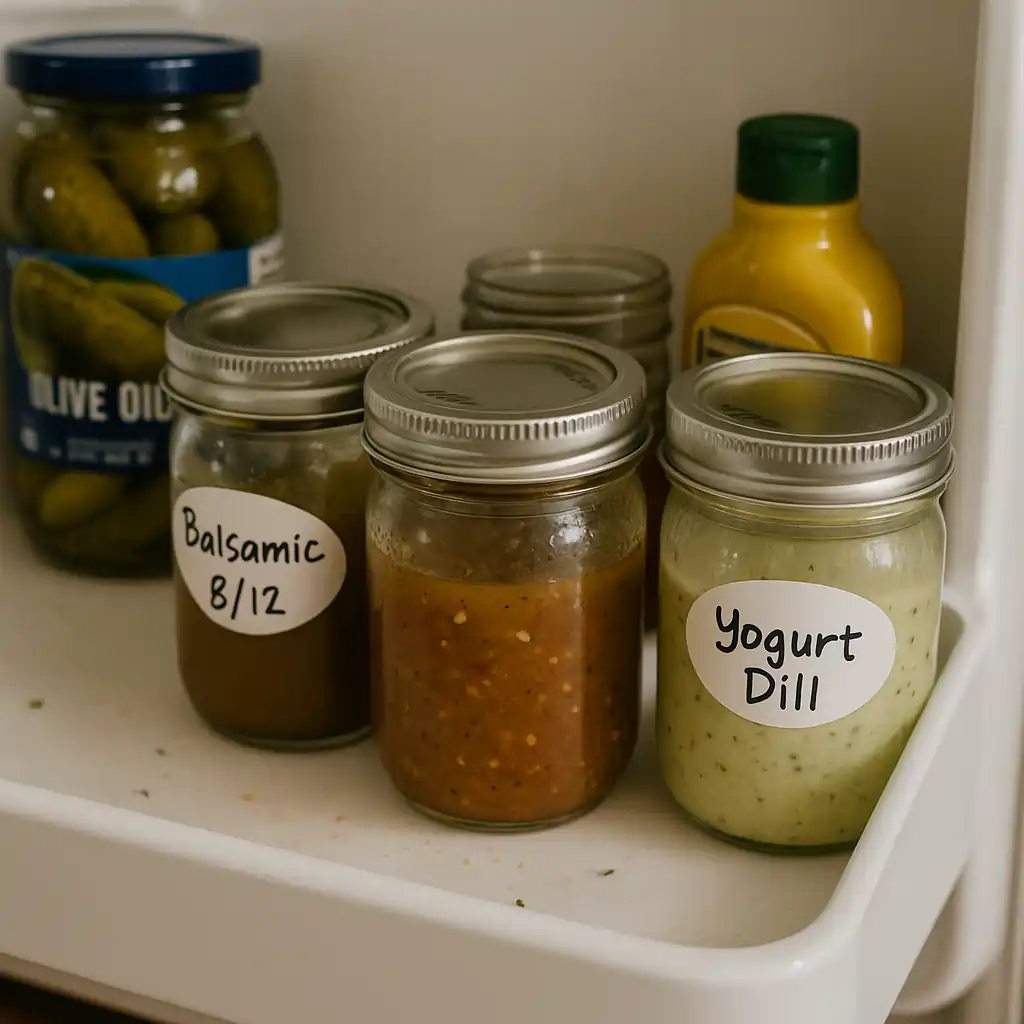
The majority of homemade salad dressing is best kept in the refrigerator. For brief periods, plain oil and vinegar with dry spices can be kept at room temperature; however, refrigeration preserves flavours and delays rancidity. I always label the jar and put it in the refrigerator if it contains fresh herbs, garlic, yoghurt, citrous juice, or mayo.
What is the duration? I try to use simple vinaigrettes with no fresh ingredients as soon as possible for the best flavour, but they keep well in the fridge for about a week or two. Dairy and fresh aromatics quickly wear off, so creamy dressings with yoghurt or mayo are at their happiest after three to five days.
Garlic in oil: a special safety note. I only make small batches, store them in the refrigerator, and use them up within a few days because fresh garlic dipped in oil can be dangerous if left out at room temperature. There is no question about it if it smells bad, appears strangely hazy, or develops fuzz.
Emulsions are moody, which causes separation. Your vinaigrette is simply resting if it splits, so give it a good shake or whisk it back together, and it will behave. In order to make stubborn dressings snap glossy again, I whisk half a teaspoon of Dijon into a small bowl and then slowly drizzle in the broken dressing.
Good olive oil solidifies when cold, so I’ve had dressings solidify in the refrigerator. I shake the jar after putting it on the counter for ten minutes or running it under lukewarm water, and it immediately loosens up. I try not to microwave because hot spots can split dairy-based dressings or dull their flavour.
I avoided mystery sauce roulette by labelling jars. To help me remember what it is and when I made it, I write down the date and the vibe, such as “balsamic + Dijon.” A new jar takes two minutes, and peace of mind is more valuable than a bloated stomach, so if you’re ever unsure, throw it out and start over.
Healthy Swaps (low sodium, sugar-free, low-FODMAP)
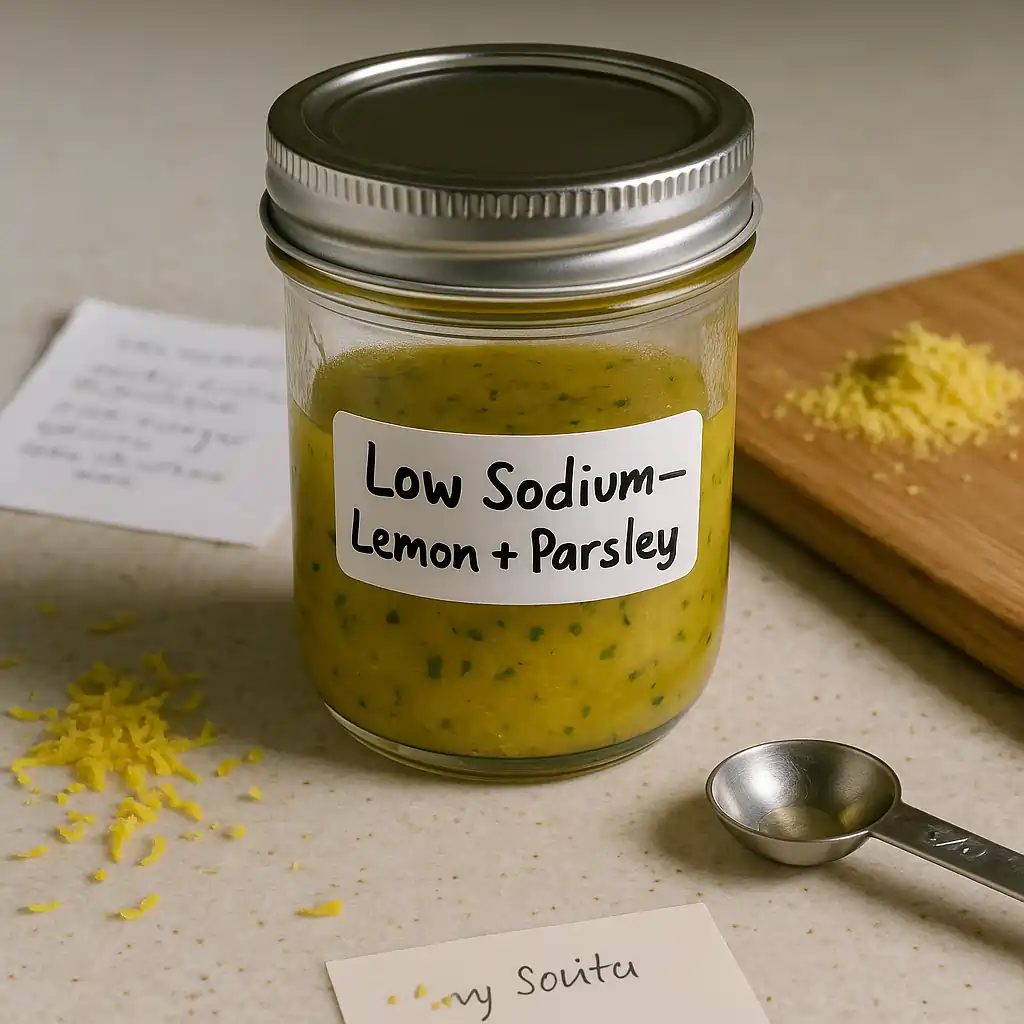
A healthy salad dressing doesn’t have to be tasteless. I rely on umami, acid, and herbs for low sodium so I don’t miss the salt, and I taste before adding more. It feels like a little culinary magic when a dash of lemon or sherry vinegar is added at the end to simulate the brightness I typically expect from salt.
I switch to a 2:1 oil to acid ratio for sugar-free or reduced-sugar products so that sweetness is not necessary for balance. I puree a few strawberries in the blender, which sounds strange but tastes great, or use small amounts of balsamic reduction if I want a touch of roundness without adding sugar. For depth, you can also use roasted garlic paste, but use sparingly to avoid overpowering it.
It is completely possible to use low-FODMAP dressings. For that onion vibe, I use chives or the green tops of scallions, use maple syrup sparingly instead of honey, and substitute raw garlic for garlic-infused oil. Here, rice vinegar and lemon are good acids, and Dijon, when used sparingly, usually behaves well.
I have a blueprint if you want one. Olive oil, red wine vinegar, Dijon, black pepper, and a tonne of chopped parsley make a basic low-sodium base. Greek yoghurt, lemon juice, garlic-infused oil, dill, and water to thin is a sugar-free, creamy alternative that doesn’t feel “diet,” I assure you.
I like linking to deeper dives for folks who want specifics. If you’re working on low-sodium ideas, check out our guide at Low Sodium Salad Dressing (No-Salt Added, Big Flavor) for full formulas and tasting notes. For no-sugar options, Sugar-Free Salad Dressing (No Added Sweeteners) is my go-to reference, and low-FODMAP fans can head to Low FODMAP Salad Dressing (Garlic-Infused Oil, No Onion) for tweaks that won’t bother your gut.
Regional & Flavor Profiles (Italian, Mexican, chipotle, honey-Dijon, etc.)
Italian vinaigrette is bright and herby and tastes like pizza night but for salad. I mix olive oil, red wine vinegar, Dijon, oregano, garlic, a pinch of chili flake, and it just sings on romaine and tomatoes. When I want to batch it, I make a dry Italian Salad Dressing Mix (DIY Packet) and scoop as needed, which saves me on busy nights.
Mexican-inspired dressings love lime, cilantro, and a touch of heat. I blend lime juice, olive or avocado oil, cilantro, a bit of cumin, and a whisper of jalapeño, and it’s perfect on chopped salads with corn and black beans. For smoky depth, chipotle in adobo turns it into a Creamy Chipotle Salad Dressing (Smoky & Spicy) situation that clings beautifully to cabbage slaw.
Honey-Dijon is the crowd-pleaser that converts “I don’t like salad” people. It’s olive oil, Dijon, apple cider vinegar, and honey, and it coats spinach or arugula like a hug. If I’m leaning balsamic, I do Honey Dijon Salad Dressing with balsamic vinegar and it gets rich and glossy in a way that feels fancy.
Apple cider vinegar dressings are my weekday workhorse. ACV tastes friendly and not too sharp, so I can push the acid a bit for a lighter, healthier vibe and still have balance, and that’s why Apple Cider Vinegar Salad Dressing shows up in my fridge a lot. It plays nice with crunchy apples, walnuts, and sharp cheddar, which is an all-star bowl.
For garlic lovers, a simple garlic salad dressing is a whole personality. Mince it fine, let it sit in lemon or vinegar first to soften, then whisk in oil and a spoon of Dijon so it doesn’t bully the greens. If raw garlic is too loud, I roast a head and squeeze in the sweet paste, and it turns mellow and cozy.
I keep a small “flavor map” in my head. Olive oil plus red wine vinegar screams Italian, avocado oil plus lime whispers Mexican, sesame oil plus rice vinegar heads to Asia, and balsamic plus honey leans comfort. Once you see those lanes, you can swap parts and still land in the right neighborhood.
Quick Formulas & Substitution Chart

These are the ones I create automatically if you prefer brief, commanding formulas. Three tablespoons of olive oil, one tablespoon of red wine vinegar, one teaspoon of Dijon mustard, and a generous pinch of salt and pepper make up a classic vinaigrette. It tastes restaurant-light when I use two tablespoons of oil and one tablespoon of lemon juice, then thin with a tablespoon of water to make it brighter.
Half a cup of Greek yoghurt, two tablespoons of lemon juice, two tablespoons of water, one tablespoon of oil infused with garlic, salt, dill, and chives make up a creamy Greek yoghurt ranch. To make a Caesar-style dish at home, combine two tablespoons lemon juice, one teaspoon Dijon, one small grated garlic clove, three tablespoons olive oil, and a spoonful of grated Parmesan cheese. Three tablespoons tahini, three tablespoons warm water, two tablespoons lemon juice, one tablespoon olive oil, salt, and a pinch of cumin are all combined to make tahini-lemon.
One ripe avocado, two tablespoons of lime juice, two tablespoons of water, one tablespoon of olive oil, and, if desired, salt and cilantro make up avocado-lime. The “everyone smiles” bottle is Honey-Dijon, which is made up of three tablespoons olive oil, one tablespoon apple cider vinegar, one teaspoon Dijon, one teaspoon honey, and salt. Two tablespoons balsamic, two tablespoons water, two tablespoons olive oil, half a teaspoon Dijon, and salt make up the balsamic glaze vinaigrette, which keeps it glossy but lighter.
I switch things wisely rather than at random when I’m missing something. No Dijon refers to using a half-teaspoon of tahini or a teaspoon of mayo to aid in emulsification without altering the intended outcome. When I don’t have lemon, I add apple cider vinegar and a small amount of orange juice to restore the fruitiness, which is oddly ideal for spinach.
Blend olive oil half and half with avocado oil to soften the edges if it tastes too strong for your simple salad dressing. Water fixes more than people realise, so if you over-acidify, whisk in a tablespoon of water and taste again instead of immediately adding more oil. You can resume your journey after adding a small amount of honey if it still stings.
FAQs
What is the easiest way to make salad dressing at home?
The shake-jar method wins because it’s fast, tidy, and great for small batches, so I add acid, salt, and aromatics first, then oil, then shake like a maraca. If it separates later, I just shake again and it’s fine.
Do I have to use mustard for a vinaigrette?
No, but Dijon is a friendly emulsifier that makes the texture silky and stable, and a half teaspoon goes a long way. If you don’t want mustard, use a small spoon of mayo or tahini to help oil and acid play nice.
How long does homemade salad dressing last?
Plain vinaigrettes usually stay tasty about one to two weeks refrigerated, while creamy or yogurt-based dressings are best in three to five days. If you used fresh garlic or herbs, I try to finish sooner for safety and flavor.
Why did my dressing separate?
Oil and water-based liquids are natural enemies, so separation is normal, and it doesn’t mean you messed up. Shake or whisk again, and if it keeps breaking, add a tiny bit of Dijon and re-emulsify to lock it in.
What’s a good low-sodium or sugar-free option?
Try a bright lemon vinaigrette at a 2:1 ratio with loads of herbs and garlic-infused oil for aroma, then salt to taste at the end so you don’t overdo it. For sugar-free, rely on balsamic’s natural sweetness or fruit puree, and keep it balanced with salt and acid so it doesn’t read “dessert.”
Conclusion
It’s not hyperbole to say that you can discover the entire world of homemade salad dressing by mastering just one ratio. Every bowl becomes simpler, quicker, and much more delectable once you can intentionally adjust the oil, acid, salt, and texture. You’ll stop chasing arbitrary recipes every time you buy greens, eat better, and waste less.
Make it your own by using this guide as a map. Make adjustments based on your preferences, your greens, and your objectives, such as low-sodium, low-FODMAP, or simply a simple, colourful salad dressing that you can shake in a jar before lunch. Label jars, keep it cold when necessary, and if something doesn’t seem right, follow your instincts and start over.
Dressings are the secret sauce (literally) that turn a plain bowl of greens into something crave-worthy. But of course, the dressing is only half the magic. If you’re ready to see how these flavors come together in full meals, don’t miss my ultimate guide to salad recipes. It’s packed with fresh ideas where you can put these dressings to work right away.
